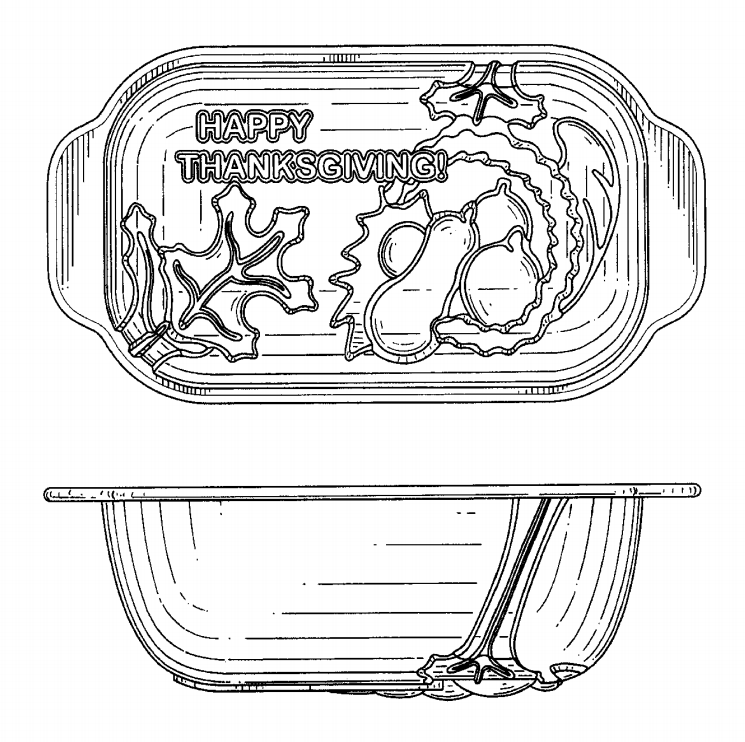
Each year, as grocery stores fill with Butterball turkeys, canned gravy, and other Thanksgiving implements, the average American will spend roughly $200 on this holiday’s expenses. These costs include not only food and liquor but also travel costs. Indeed, the day before Thanksgiving and the Sunday thereafter are often the busiest travel days of the year with an estimated nearly 3 million people taking to the skies. As a result, companies and inventors alike have taken to the intellectual property system to address America’s needs with regard to turkey day.
An early turkey related patent involved a “Toy Representing a Turkey Gobbler,” the toy being made principally from pine burrs. Since that invention, others have created A Process for De-Boning a Turkey (U.S. Patent No. 6,572,467), a Cooking Jacket (U.S. Patent No. 4,942,809), and a Method of Preparing Turkey Product (U.S. Patent No. 3,347,680). Another turkey-related patent was granted in 2005 for a method and apparatus for preparing a roast turkey analog from vegetarian substitutes, which comprises a turkey mold. These are all examples of utility patents, which provide the inventor or assignee the right to exclude others from commercially exploiting or otherwise making use of the patented invention without the patentee’s authorization.
Moreover, many inventors have filed design patents having a Thanksgiving spirit. For instance, U.S. Patent No. D397,955, which issued in 1998 to Schmidt, depicts a turkey decoration featuring a plump turkey with proud tailfeathers. Another, U.S. Patent No. D184,815 for a Combined Cornucopia and Candleholder, includes three distinct candleholders set on a cornucopia. As a final example, U.S. Patent No. D527,217 issued in 2005 for a Thanksgiving Embossed Insert for Baking Pan which appears as a standard rectangular baking pan with harvest-type décor and the phrase “Happy Thanksgiving!”
Design patents are granted to any person who has invented any new, original, and ornamental design for an article of manufacture. A design patent protects only the aesthetic appearance of the article and not any accompanying structural or utilitarian features. This means, for instance, the inventor of the Thanksgiving Embossed Insert for Baking Pan can prevent others from copying their particular design of a baking pan insert but not from using a baking pan insert in general. Design patents have a term of fourteen years which grants the aforementioned inventors of these various Thanksgiving designs fourteen consecutive Thanksgivings during which to monopolize their design.
Other examples of turkey day intellectual property include copyright registrations for songs and poems commonly associated with the holiday. Adam Sandler likely holds the copyright for “The Thanksgiving Song.” Similarly, “A Charlie Brown Thanksgiving” by Vince Guaraldi Trio and even “Five Little Turkeys” by The Learning Station are subject to copyright protection. Under copyright principles, these artists’ works are protected provided they constitute original works of authorship, which requires at least minimal creativity.
Finally, a number of individuals and companies hold trademarks for various Thanksgiving terms and phrases. As fans of the popular television show “Friends” will appreciate, “Thanksgiving Pants” is registered for pajama bottoms. Additionally, Macy’s West Stores, Inc. has held the mark “Macy’s Thanksgiving Day Parade” as applied to entertainment services, namely, organizing and conducting a parade, since 1998. There are also multiple registrations for various cities’ turkey trots, such as the “San Francisco Turkey Trot.”
Even the basic term “Thanksgiving” has a few registrations. For example, Multimedia Games, Inc. owns the word as applied to computer game software for gaming machines, namely, slot machines and video lottery terminals. Another registrant owns the term in connection with jerky, meat-based snack foods, and dried meat. It is important to note that a registered mark only allows the holder to prevent others from using that term or phrase in connection with similar goods or services in such a way that it is likely to cause the consuming public to be confused. To illustrate, if one were to use “Thanksgiving” on a coffee mug, this would not infringe the trademarks for gaming machines or jerky.
While these numerous examples of intellectual property can be viewed as attempts to extort America’s dedication to Thanksgiving, the alternate perspective is to feel grateful that so many creative minds have consistently been envisioning ways to make the holiday more convenient, efficient, or even enjoyable.
